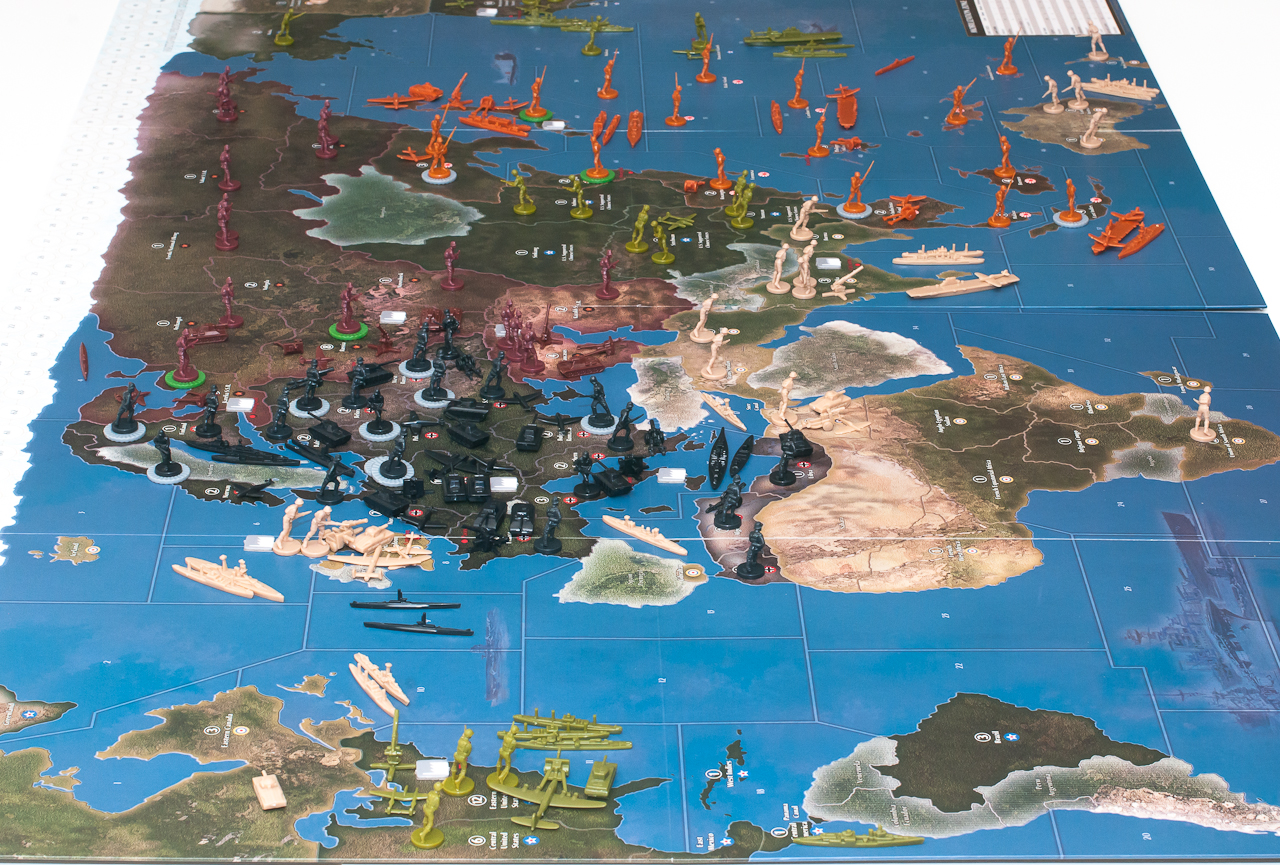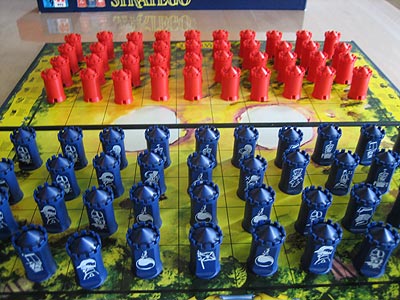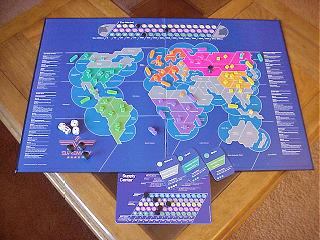Saturday, 6 April 2013
Friday, 5 April 2013
Supremacy: The Game of the Superpowers
Supremacy: The Game of the
Superpowers is a political, economical and military strategic board wargame
published in 1984 by Supremacy Games and design by Robert J. Simpson. Supremacy
pits conventional superpowers against each other for control of the earth
similar to a modern warfare Risk with an integrated supply and demand economic
system. Warfare comes in multiple forms of conventional, biological, chemical
and nuclear. (Supremacy: The Game of the Superpowers) The players
represent the superpowers of the world; the United States, the Soviet Union,
the League of European Nations, the People's Republic of China, the Confederacy
of South America and the Federation of African States. The goal is to conquer
the world either through military or economic strength. Players can build army
and naval units and to do so requires resources. There are three types of
resources in the game; oil, wheat and minerals. Once the units are built they
require a continual input of resources in the form of maintenance. Armies
require grain to move and navies require oil. In addition, salaries must be
paid for each army and naval unit. Each country on the board is capable of
producing certain types of resources. Players can gain access to those
resources by capturing the country in question and playing the appropriate
resource card. Alternatively, players can buy or sell resources on the global
market. The game also spawned a great number of supplements to
expand the game further. (Supremacy: The Game of the
Superpowers)
Nuclear War
Nuclear War is a multiplayer card
game designed by Douglas Malewicki and originally published in 1965. It is a satirical
game in which each player represents a ‘major world power’ and attempts to gain
global domination or annihilation through the strategic use of propaganda or
nuclear weapons. (Nuclear War) If you choose do,
players can choose to use one of the joke countries that come with the game or
you could choose an existing country. Each country has its own traits for
example Bagmad, the terrorist state, can send 10 and 20 megaton bombs up the
track to attack enemies without inciting nuclear war. Bananaland, also known as
Cuba, can give population to opponents to make them lose turns. Players can use
propaganda cards to destroy thier enemies. If you wipe out your enemy through
propaganda their game will end, however, if they are wiped out through secrets
or bombs they get what's called a final retaliation. That is the equivalent of pressing
a self-destruct button and attempting to destroy everyone. (Gronli, 2009) The game and its multiple
expansions have won multiple awards such as the Charles Roberts Award for Best
Science Fiction Boardgame of 1983 (List of Winners) and has been inducted
into the Origins Adventure Gaming Hall of Fame.
Axis & Allies
Axis
& Allies is a series of World War 2 strategy board games created by game
designer Larry Harris Jr. and published by Nova Game Designs in 1981 and
reprinted in 1984 by the Milton Bradley Company. It is intended to be played by
two to five players over the age of twelve with games lasting anywhere between
and around two to ten hours. The game is incredibly popular within the board
gaming community printing two million copies since its release. Players play as
members of the Axis – Japan and Germany - or Allies – UK, US and Soviet Union –
with the Axis players teaming up against the Allied powers in an attempt to
conquer key territories represented by regions on the board. This was done in
earlier models by capturing and holding certain territories until the end of a
round after each player has moved according to a specific order. (General M.
Bradley, 1991) Players have at their disposal
infantry, armour, fighters, bombers, battleships, aircraft carriers,
submarines, troop transports, anti-air guns, and factories. All of the units
perform differently and many have special functions. Players have to work
together with their team mates in order to coordinate offences and decide how best to utilize their production points. (Axis &
Allies)


Warhammer 40,000
Warhammer 40,000 or informally named Warhammer 40K is a tabletop wargame played using miniature figurines first designed by Rick Priestley and produced by Games Workshop in 1987 as Warhammer 40,000: Rogue Trader – which is considered to be the best of collection because of its diverse universe and free-form rules.
Stratego
Stratego is a strategy board game
to be played by two players with fairly simplistic rules. Trademarked in 1947
by Dutchman Jacques Johan Mogendorff and originally manufactured distributed by
Jumbo, the Milton Bradley Company bought the rights to it and distributed it
across America to commercial success leading to future releases of licensed
variants of the game. However the original idea for the game was patented by a
French women named M. Hermance Eden in 1908 as ‘jue de bataille avec pieces
mobiles sur damier’ which translates to ‘ a battle game with mobile pieces on a
game board’. The game soon sold as L’Attaque is generally considered an ancestor
and the inspiration for Stratego and was very popular all over Europe especially
throughout World War 2 due to the common theme of war that engulfed this during
this period. Although first advertised and catered towards an adult audience,
Stratego quickly became a family favourite and today has amassed a large fan base
reaching across the world and has even been adapted to be played as a computer
game and over the internet. (History) The objective of the
game is to find and capture the opponents flag or capture so many enemy pieces
they are unable to move, this is achieved through players landing on their enemies
pieces and both player’s piece subsequently being revealed with the weaker of
the two pieces being removed from the board.


Dungeon and Dragons
Dungeons and Dragons is a fantasy, role-playing game originally
designed by Gary Gygax and Dave Arneson and first published in 1974. (Dungeons and
Dragons FAQ)
Dungeons and Dragons derived from wargames but departs from traditional
wargaming assigning each player a specific character rather than an army or
group of units. It is widely considered as the beginning of modern role-playing
games and amassed a fan base of 3.5 million players around the world 7 years
after release and a total of twenty million players in total overall. It is the
most widely recognised and played role-playing game and has been sold is 50
countries and translated into a dozen languages and has released multiple
editions over the course of the last 39 years. The game focuses on players
grouping together and creating ‘parties’
of adventurers, during the course of the game each player directs the
actions of their character and their interactions with other characters which
is performed via verbal impersonations of their characters. The rules and
events of the game are depicted by the Dungeon Master who selects various NPCs
, party encounters and the settings in which these events occur with the
outcome of these encounters based upon the player’s choices and actions. Each individual
character has multiple different attributes that are determined at the beginning
of the game by each player with more recent versions of the game determining
the attribute values using a points system.
Subscribe to:
Posts (Atom)








